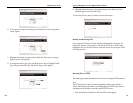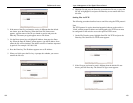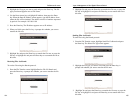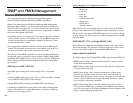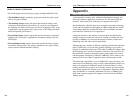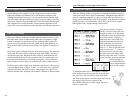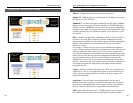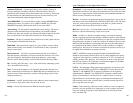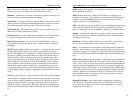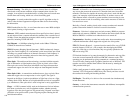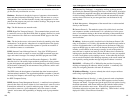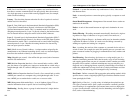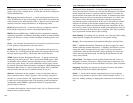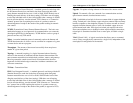
SPI (Stateful Packet Inspection) - A firewall technology that monitors the
state of the transaction so that it can verify that the destination of an inbound
packet matches the source of a previous outbound request. It examines not
just the headers of the packet, but also the contents, to determine more about
the packet than just its source and destination information. It is called "state-
ful" because verifies that the stated destination computer has previously
requested the current communication. In this way, it verifies that all commu-
nications are initiated by the recipient computer and are taking place only
with sources that are known and trusted from previous interactions. In addi-
tion to being a more rigorous inspection, stateful packet inspection closes off
ports until connection to the specific port is requested. This allows an added
layer of protection from the threat of port scanning.
Static Routing - Forwarding data in a network via a fixed path. Static routing
cannot adjust to changing line conditions as can dynamic routing.
Storage - The semi-permanent or permanent holding place for digital data.
STP - 1. (Shielded Twisted Pair) Telephone wire that is wrapped in a metal
sheath to eliminate external interference. 2. (Spanning Tree Protocol) A tech-
nology that checks your network for any loops. A loop can often occur in
complicated or back-up linked network systems. Spanning-tree detects and
directs data along the shortest path, maximizing the performance and effi-
ciency of the network.
Subnet Mask - The method used for splitting IP networks into a series of
subgroups, or subnets. The mask is a binary pattern that is matched up with
the IP address to turn part of the host ID address field into a field for subnets.
Swapping - Replacing one segment of a program in memory with another
and restoring it back to the original when required.
Switch - 1. A data switch connects computing devices to host computers,
allowing a large number of devices to share a limited number of ports. 2. A
device for making, breaking, or changing the connections in an electrical cir-
cuit.
125
Layer 2 Management 4-Port Gigabit Ethernet Switch
ProConnect II
®
Series
RAID improves performance by disk striping, which interleaves bytes or
groups of bytes across multiple drives, so more than one disk is reading and
writing simultaneously.
RIP (Routing Information Protocol) - A simple routing protocol that is part
of the TCP/IP protocol suite. It determines a route based on the smallest hop
count between source and destination. RIP is a distance vector protocol that
routinely broadcasts routing information to its neighboring routers.
RJ-45 (Registered Jack-45) - A connector similar to a telephone connector
that holds up to eight wires, used for connecting Ethernet devices.
RMON (Remote MONitoring) - RMON provides comprehensive network
monitoring capabilities. It eliminates the polling required in standard SNMP,
and can set alarms on a variety of traffic conditions, including specific error
types.
Server - Any computer whose function in a network is to provide user access
to files, printing, communications, and other services.
SMTP (Simple Mail Transfer Protocol) - The standard e-mail protocol on
the Internet. It is a TCP/IP protocol that defines the message format and the
message transfer agent (MTA), which stores and forwards the mail.
SNMP (Simple Network Management Protocol) - A widely used network
monitoring and control protocol. Data is passed from SNMP agents, which
are hardware and/or software processes reporting activity in each network
device (hub, router, bridge, etc.) to the workstation console used to oversee
the network. The agents return information contained in a MIB (Management
Information Base), which is a data structure that defines what is obtainable
from the device and what can be controlled (turned off, on, etc.).
Software - Instructions for the computer. A series of instructions that per-
forms a particular task is called a "program." The two major categories of
software are "system software" and "application software." System software
is made up of control programs such as the operating system and database
management system (DBMS). Application software is any program that
processes data for the user.
A common misconception is that software is data. It is not. Software tells the
hardware how to process the data.
124



